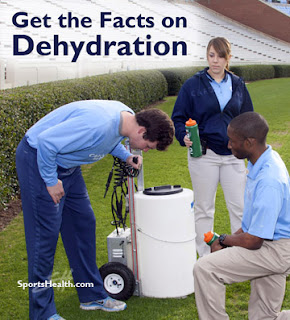About the Diabetic Teenaged Athlete
Adolescent diabetics who play sports need to be very good at disease management but also time, food, exercise, rest, illness and fluid management. A diabetic teenager lacks the capacity to control blood glucose without supplemental insulin.
Glucose is the primary sugar circulating in your blood. Normally, after a meal, food gets digested and broken down into easily absorbed molecules, glucose being one of them. Glucose is a simple sugar that comes mostly from the carbohydrate that you eat. It must be present in your blood in sufficient quantity that your brain and nervous system can take it up and use it as their primary fuel.
Teachers, coaches and parents all encourage teens to eat breakfast because “breakfast” is actually “break” and “fast” which means morning blood sugar levels are low due to the fast of not having eaten overnight.
Low blood sugar levels impact brain tissue negatively, causing:
- drowsiness
- fatigue
- lack of attention
- mental “drifting”
Not good qualities to have during school or sports!
Exercise is very useful to diabetics as it assist in mainlining good blood glucose control. A successful diabetic teenager who is also an athlete must become very good at organizing and preparing for the unexpected.
Balencing Diet, Exercise, and Diabetes
The interplay between insulin therapy, diet, and exercise is extremely important to athletes with diabetes. The goal is to match the type, amount, and timing of insulin to food intake and activity level. Regular monitoring of blood glucose levels is critical to ensuring that appropriate amounts of insulin are provided and metabolic complications are avoided. When insulin levels are not in balance with need, abnormalities in blood glucose and acid concentration can occur. By adjusting your insulin dose depending on the length and intensity of exercise, control of blood glucose level can be enhanced.
This is a subject you’ll want guidance on from your physician.
Including carbohydrate-containing foods with a low glycemic index can assist with blood glucose control.
Glycemic index is a tool used to rank foods according to their immediate effect on blood glucose levels. Carb-containing foods that are broken down quickly will rapidly release glucose into the bloodstream. These are known as high glycemic index foods. Those that break down slowly gradually release glucose into the bloodstream. These are known as low glycemic index foods, and this latter category can be advantageous for those with diabetes. (
www.powerbar.com)
Young diabetics have a great deal to learn about the disease, exercising demands as well as rest, fluids and the type /amount of food eaten.
Exercise is important for all of us, but it is vital to diabetics.
Learn about the condition, speak with your physician often and don’t be afraid...athletes with diabetes have competed successfully on all levels.
61 Famous Athletes with Diabetes
Arthur Ashe - Tennis - Wimbledon winner.
Walter Barnes - Football and actor. Before acting career he played professional football for the NFL's Philadelphia Eagles, 1948-1951.
Ayden Byle - Runner - First insulin-dependent man to run 6521.5 km across North America.
Nick Boynton - Hockey Player - Boston Bruins.
Doug Burns – Fitness consultant, Record-holding strength athlete.
Sean Busby - Champion Snowboarder.
Bobby Clarke - NHL - Philadelphia Flyers.
Ty Cobb - MLB - Detroit Tigers.
Scott Coleman - Swimmer - first man with diabetes to swim the English Channel.
Jay Cutler - Football Player.
Chris Dudley - NBA - New York Knicks center.
James “Buster” Douglas - Heavy Weight Boxer.
Kenny Duckett - NFL - New Orleans Saints.
Scott Dunton - World Class Surfer.
Mike Echols - NFL - Tennessee Titans.
Pam Fernandes - Para Olympian.
Missy Foy - Professional Marathon Runner.
Curt Frasier - NHL - Chicago Black Hawks.
Walt Frazier - NBA - New York Knicks.
“Smokin’ Joe” Frazier - Boxing.
Kris Freeman - Olympic and National Champion Cross-Country Skier.
Joe Gibbs - NFL - Washington Redskins coach.
Jorge "Giant" Gonzalez- Professional Wrestler and Argentinian Basketball Player.
Bill Gullickson - MLB - Cincinnati Reds Pitcher.
Gary Hall Jr. - US Olympic Gold Medalist, Swimming.
Jonathan Hayes - NFL - Pittsburgh Steelers, Kansas City Chiefs.
Jay Hewitt - Ironman Triathlete.
Dave Hollins - 1993 Phillies World Series Third Baseman.
James "Catfish" Hunter - MLB - Pitcher, Baseball Hall-of-Famer.
Chuck Heidenrich - Skiing.
Chris Jarvis - World Champion Canadian Rower.
Jason Johnson - MLB - Pitcher, Cleveland Indians.
Kelli Keuhne - LPGA golfer.
Billie Jean King - Tennis.
Jay Leeuwenburg - NFL - Indianapolis Colts Lineman.
Mark Lowe - Major League Baseball.
Michelle McGann - LPGA golfer.
Brandon Morrow -Seattle Mariners Pitcher.
David Pember - MLB - Milwaukee Brewers.
Toby Petersen - NHL - Pittsburgh Penguins, Dallas Stars.
Sir Steven Redgrave - Rower - Winner of five consecutive Olympic gold medals.
Dan Reichert - MLB - Kansas City Royals.
Ham Richardson – Tennis star.
Jackie Robinson - Baseball Hall of Fame.
Sugar Ray Robinson - Boxing.
Ron Santo - MLB - Chicago Cubs legend.
Mike Sinclair - NFL - Philadelphia Eagles.
Kendall Simmons - NFL - Pittsburgh Steelers.
Ron Springs - NFL - Dallas Cowboys.
Jerry Stackhouse - NBA - Dallas Mavericks.
Hank Stram - NFL - Kansas City Chiefs Coach.
Bradley Suttle - Texas Longhorns - Second Baseman.
Bill Talbert - Hall of Fame tennis player.
Jack Tatum - NFL - Oakland Raiders.
Sherri Turner - LPGA golfer.
Scott Verplank - PGA golfer.
Jo Ann Washam - LPGA golfer.
David "Boomer" Wells - San Diego Padres Pitcher.
Dominique Wilkins - Basketball Player (Atlanta Hawks).
Wade Wilson - NFL player and Dallas Cowboys quarterback coach.
Dmitri Young - MLB Outfielder, first baseman
Use
http://www.diabetes-exercise.org as a beginning point for information and
Sports Health for
diabetes supplies.
Phil Hossler, ATC has been an athletic trainer on the scholastic, collegiate and Olympic levels. He has authored 4 books and numerous articles and served as an officer in state and regional athletic training associations for 20 years. He is a member of four halls of fame including the National Athletic Trainers’ Association’s.





















